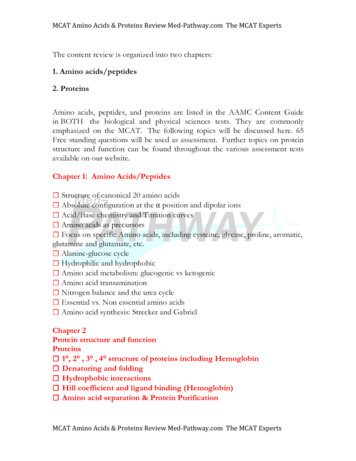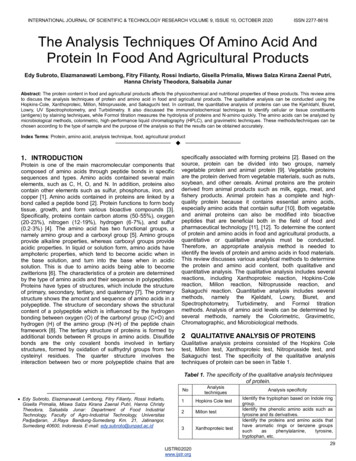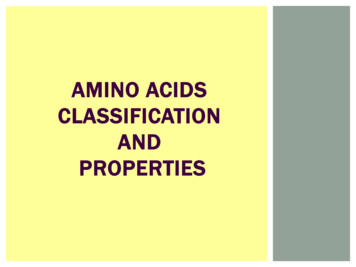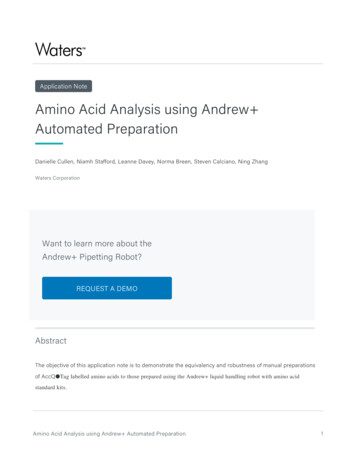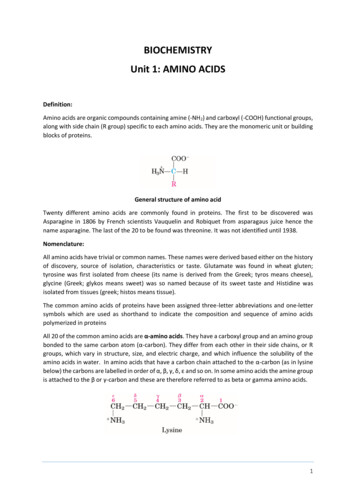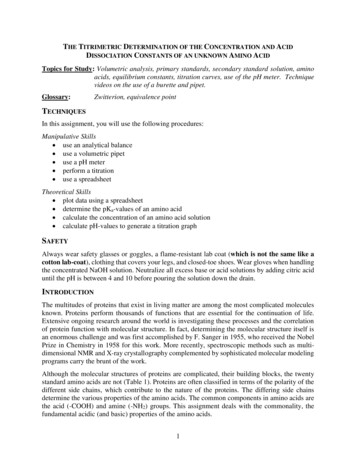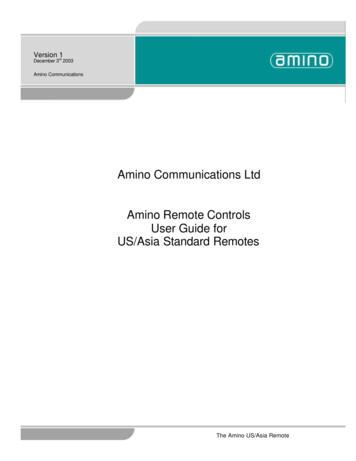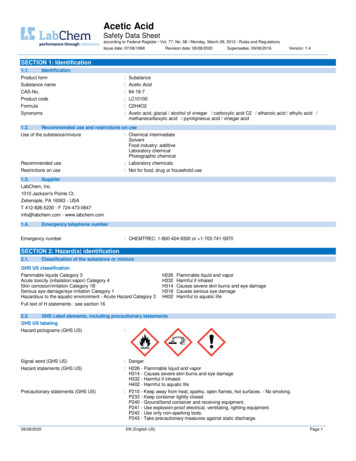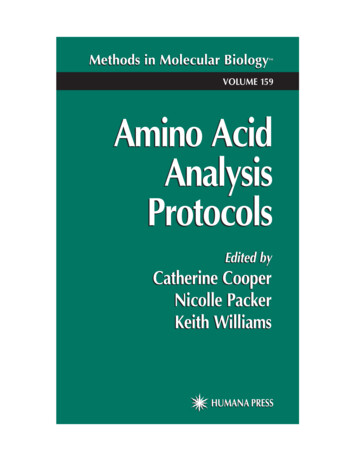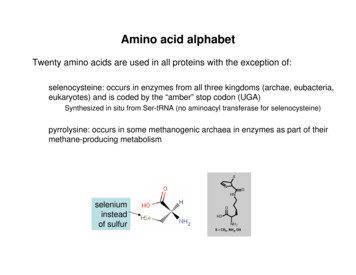
Transcription
Amino acid alphabetTwenty amino acids are used in all proteins with the exception of:selenocysteine: occurs in enzymes from all three kingdoms (archae, eubacteria,eukaryotes) and is coded by the “amber” stop codon (UGA)Synthesized in situ from Ser-tRNA (no aminoacyl transferase for selenocysteine)pyrrolysine: occurs in some methanogenic archaea in enzymes as part of theirmethane-producing metabolismseleniuminsteadof sulfur
The relative abundances of individual amino acids on primordial earthwere probably different than they are today and thus the amino acidalphabet may have consisted of fewer (or more) than 20 amino acids– Osawa et al Microbiol Review 56, 229 (1992)Also protein structures are often tolerant to amino acid substitutionsHow did the current amino acid alphabet evolve?The standard alphabet may consist of the smallest and cheapest aminoacids that form a functional protein libraryHelps identify homologous proteins and is crucial for homology modelingThe sequence structure relationship may become more apparent ifproteins can be engineered using fewer than 20 amino acids
T4 lysozyme with A40-49Can we engineer functional protein with well defined structure usingfewer than 20 amino acids and what is the minimum number of aminoacids required for the task?Mutate multiple residues simultaneously to see if a large set of aminoacids can be altered in combination to a much smaller set withoutperturbing the structure and function irreversiblyResidues 39 to 50 T4 lysozyme form an alpha helixMutate residues 40 to 49 with 10 consecutive AlaHeinz et al. PNAS 89, 3751 (1992)
Depending on the number of substitutions, the mutants are destabilizedby Tm - 8.5 – 10.7 C and G 2.1 – 2.5 kcal/mol at pH 3.0 and 6.7Yet they preserve the overall the structuremain chain atoms overlap
Minimal homeodomainHomeodomain is a conserved DNA binding domain thatis ubiquitous among developmental regulatory proteinsfrom nematodes to humansConsists of 3 alpha helices and a long N-terminal armA consensus sequence can be generated by sequencecomparison and identify residues that are important fortertiary structure and DNA binding activityHomeodomain proteins also exhibit sequence specificity contributed bynonconserved residuesShang et al, PNAS 91, 8373 (1994)
Goal: Design a “minimal”homeodomain containing allconsensus residues, in which all nonconserved residues have beensubstituted with alanineConsensus residues containsufficient sequence information toconstruct the “scaffold” for specificDNA recognitionNon-conserved residues in the Nterminal arm are required for highaffinity DNA binding as well as fortertiary structureIt is possible to design a vastlysimplified high affinity mutant with alarge number of Alagel shift assay
“Peptitergent” to solubilize membrane proteinStructural determinants of alpha helical peptides are well understoodAlpha helical peptide of 24 residue peptide-detergent PD1(“peptitergent”) was designed to self-associate and to solubilizetransmembrane proteins– Schafmeister et al, Science 262, 734 (1993)PD1 is amphipathic with Ala and Leu on one side
Helix bundle with 7 amino acidsFour helix bundles are versatile. Design and characterize an antiparallelfour helix bundle DHP1 using an alphabet of seven amino acids– Interhelical loops consist of 3, 4 and 3 glycines– Lys, Glu, Gln, Ala, Leu, Gly, Ace (capping residue)Helices cross each other at -20 Hydrogen/deuterium exchange shows that amideprotons are shielded from solvent exchangewith a protection factor 1.6 x 10 4Cf. For molten globule proteins, the protectionfactors are 100In native proteins, between 1000 – 5 x 10 8Sufficiently ordered structure can be designedusing only seven amino acidsSchafmeister et al, NSB 4, 1039 (1997)
Hydrogen-deuterium (H/D) exchangeAmide protons constantly exchange with the solventIf the protein is submerged in heavy water (D2O instead of H2O), then afterlosing its original hydrogen an amide nitrogen will pick up a deuteriumThe rate of exchange can be monitored by mass spec or by NMRgreen: no exchangeblue: too fastred: just rightH/D exchange can be used to :Measure the rate of folding and unfoldingSolvent accessibility at protein-protein interfacesDetermine disordered regions of native, folded protein—hence stability as well
Binary patterningIs it possible to design a protein by specifying just its hydrophobicity patternwithout the amino acid identities?The hydrophobicity pattern on a helix repeats itself roughly every 3.6 aminoacids. Test if a randomized peptide with the hydrophobicity pattern of a helixactually folds to a helical proteinKamtekar et al,Science 262, 1680(1993)
Binary patterned library Identify the residue positions required to be hydrophobic andhydrophilicSynthesize genes to introduce F, L, I, M or V at 24 hydrophobicpositions, and D, E, K, N, Q, and H at 32 hydrophilic positionstotal diversity: 5 24 6 32 4.7 x 10 41
Beta sheet protein with reduced alphabetHelices and helical domains are in general easier than beta sheetsCan a beta sheet protein be similarly engineered using a reduced alphabet?SH3 domain is a small beta barrel like structurethat binds a proline-rich peptideReplace all residues not involved in ligand bindingwith a small set of amino acids includingI, K, E, A, G, but maintainingRiddle et al, NSB 4, 805 (1997)ligand binding site
Enzyme from 9 amino acidsCan a reduced amino acid alphabet support enzymatic catalysis?Designing/engineering an enzyme is difficult because of the precisepositioning of residues required for catalysisChorismate mutase (CM) catalyzes the rearrangement of chorismate toprephenate and is essential for the biosynthesis of aromatic residuesThe enzyme is a domain-swapped homodimer ofthree helices and two loopsAssay: express a mutant CM in a strain deficient in theenzyme (“auxotrophic”) and select for viable clones
1. Active site: Q88, R11, R28, R51 E N Dkcat is 3-fold lower than wild typekM is 40 fold higher2. Loop #2: H66, V683. Loop #1: G43-I44-P45-I46D, E, N, K, R, F, I, L, Mi. ii. mutantiii. wild typeiv. pos controlv. neg control
alphabet may have consisted of fewer (or more) than 20 amino acids - Osawa et al Microbiol Review 56, 229 (1992) Also protein structures are often tolerant to amino acid substitutions How did the current amino acid alphabet evolve? The standard alphabet may consist of the smallest and cheapest amino acids that form a functional protein library

